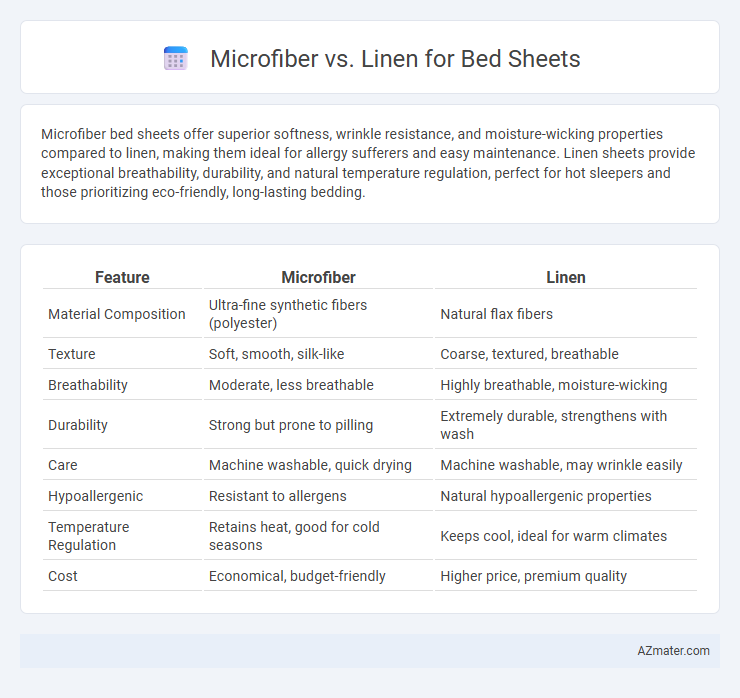Microfiber bed sheets offer superior softness, wrinkle resistance, and moisture-wicking properties compared to linen, making them ideal for allergy sufferers and easy maintenance. Linen sheets provide exceptional breathability, durability, and natural temperature regulation, perfect for hot sleepers and those prioritizing eco-friendly, long-lasting bedding.
Table of Comparison
| Feature | Microfiber | Linen |
|---|---|---|
| Material Composition | Ultra-fine synthetic fibers (polyester) | Natural flax fibers |
| Texture | Soft, smooth, silk-like | Coarse, textured, breathable |
| Breathability | Moderate, less breathable | Highly breathable, moisture-wicking |
| Durability | Strong but prone to pilling | Extremely durable, strengthens with wash |
| Care | Machine washable, quick drying | Machine washable, may wrinkle easily |
| Hypoallergenic | Resistant to allergens | Natural hypoallergenic properties |
| Temperature Regulation | Retains heat, good for cold seasons | Keeps cool, ideal for warm climates |
| Cost | Economical, budget-friendly | Higher price, premium quality |
Introduction to Microfiber and Linen Bed Sheets
Microfiber bed sheets are made from finely woven synthetic fibers, typically polyester, known for their softness, durability, and wrinkle resistance. Linen bed sheets, derived from flax plant fibers, offer exceptional breathability, moisture-wicking properties, and a naturally textured feel that softens with each wash. Both materials cater to different preferences, with microfiber excelling in affordability and ease of care, while linen provides a luxurious, breathable option ideal for warm climates.
Material Composition: Microfiber vs Linen
Microfiber bed sheets are made from finely woven synthetic fibers, typically polyester, offering a smooth, soft texture that resists wrinkles and stains. Linen sheets consist of natural flax fibers, known for their breathability, moisture-wicking properties, and durability that improves with use. The choice between microfiber and linen hinges on preferences for hypoallergenic properties, temperature regulation, and fabric maintenance.
Comfort and Feel: Which Is Softer?
Microfiber bed sheets offer a smooth, silky texture that feels soft and lightweight against the skin, making them a popular choice for those seeking a plush and cozy sleeping experience. Linen sheets provide a unique, breathable fabric with a slightly textured feel that softens over time, delivering a natural, airy comfort ideal for warm climates. While microfiber excels in immediate softness, linen appeals to sleepers who prefer a durable, breathable material that becomes softer after repeated washes.
Breathability and Temperature Regulation
Microfiber bed sheets offer excellent temperature regulation by trapping heat, making them ideal for cooler climates or winter use. Linen sheets outperform microfiber in breathability, allowing superior airflow that keeps sleepers cool and comfortable in warm or humid conditions. Choosing linen enhances moisture-wicking and natural temperature balance, while microfiber provides softness with moderate thermal insulation.
Durability and Longevity
Microfiber bed sheets are known for their durability due to tightly woven synthetic fibers that resist wear and tear over time, making them less prone to fading and shrinking. Linen sheets, crafted from flax fibers, offer remarkable longevity as they naturally strengthen with each wash, becoming softer and more resilient despite initial coarseness. While microfiber provides consistent performance and easy maintenance, linen's durability is enhanced by its breathable, moisture-wicking properties, ensuring long-term comfort and resilience.
Ease of Care and Maintenance
Microfiber bed sheets are highly favored for their ease of care, requiring minimal effort with quick drying times and resistance to wrinkles and shrinking due to their synthetic polyester composition. Linen sheets demand more maintenance, needing gentle washing and occasional ironing to maintain their natural texture and breathability, but they become softer and more durable with each wash. Both materials offer durability, but microfiber is ideal for hassle-free care, while linen provides a luxurious feel with a commitment to careful upkeep.
Hypoallergenic Properties and Skin Sensitivity
Microfiber bed sheets are made from finely woven synthetic fibers that resist dust mites and allergens, making them an excellent choice for hypoallergenic bedding. Linen sheets, derived from natural flax fibers, offer breathability and moisture-wicking properties that reduce irritation for sensitive skin while naturally resisting bacteria. Both materials provide hypoallergenic benefits, but microfiber excels in allergen resistance, whereas linen is preferred for its skin-friendly, breathable texture.
Eco-Friendliness and Sustainability
Microfiber bed sheets are made from synthetic materials such as polyester, resulting in lower biodegradability and potential microplastic pollution, which impacts their eco-friendliness negatively. Linen, derived from flax plants, is highly sustainable due to its natural fiber composition, minimal water requirements, and biodegradability, making it an environmentally responsible choice. Choosing linen over microfiber reduces carbon footprint and supports sustainable agricultural practices, contributing to long-term environmental benefits.
Cost Comparison: Microfiber vs Linen Sheets
Microfiber sheets are generally more affordable, with prices often ranging from $20 to $50 per set, making them a budget-friendly option for soft, wrinkle-resistant bedding. Linen sheets typically cost significantly more, usually between $80 and $200, reflecting their natural fibers, durability, and breathability. Choosing between microfiber and linen often depends on balancing initial cost against long-term value and comfort preferences.
Choosing the Best Bed Sheet for Your Needs
Microfiber bed sheets offer affordability, wrinkle resistance, and softness ideal for allergy sufferers, while linen sheets provide superior breathability, durability, and moisture-wicking properties suitable for hot sleepers. Choose microfiber for budget-friendly, easy-care options and linen for luxurious comfort and long-term investment in temperature regulation. Assess personal preferences for texture, climate, and maintenance to determine the optimal fabric for restful sleep.

Infographic: Microfiber vs Linen for Bed Sheet
 azmater.com
azmater.com